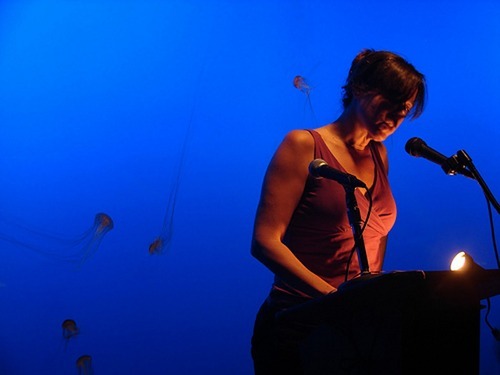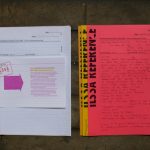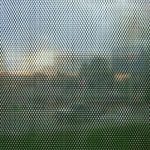Meet a NYFA Artist: Cara Benson
NYFA speaks with 2011 Poetry Fellow Cara Benson.
NYFA: Hi Cara, can you tell us about what you’re working on?
CB: I’ve just completed my second book of poetry called “Funny. Considering how heated it was.” I’ve described this project, which has the subtitle Protean Parade, as partly choral or symphonic in its use of voices and source material. There is also a lone speaker in it. So I think it’s a project of scale in that it moves from the intimacy of the “I” to an evolutionary consideration and attempted representation of the furthest extensions of existence in matter and address.
The voices and quotes that populate the text are important to me because I think we are shaping new aesthetics in the age of globalization. This is more than just art for art’s sake. Art as it reflects, participates in, and generates socio-ethno-politico-econo-enviro-everything. How we are living on the planet at this time, fully imbricated. Voices, internetted exchanges, media as commodity and re-evaluation of the individual within the plural seem to have emerged as key elements. After the linguistic turn and the questioning of identity generally and specifically in language – the speaking “I” — I think many who feel so voiceless in the hegemonic world order are seeking new ways to speak.
So now I’m working on my third full length work, titled spreek. This project is engaged with some of the same concerns but is stressing the visual even further. If we are indeed the society of the spectacle with vision now the primary sense, I want to and feel called to consider the eye when creating for the page. However, one of the many beautiful things to me about the Occupy Wall Street and Occupy Everything movement is the centrality of the spoken voice and the gesturing body. Consensus is felt at these assemblies rather than solely observed. So, how to feel the work on the page. As there is an internal voice we hear when reading — though I don’t know about readers with no external hearing — we do, I think, internally feel the words of a written work. Especially if there is some interruption to a seamless flow of language; that can be where the visual comes in. It creates a pulse.
NYFA: What are some the people, things, or ideas that are influencing you strongly right now?
CB: Political theorist Jodi Dean talks about the stage of capitalism we are in as communicative capitalism. That we are enjoined to hypercontribute through “social media” and hence there is an overproduction of “communication.” We are providing the content for free, and just a few are profiting from this. There’s much more to her work, but when I think about the economy of speculation and complicated math rather than money as representing something tangible – a service or good — I often think of the crowding and drowning of voices usurped by these owned and manipulated networks. Something somehow spectral. Corporatism and privatization — such a baneful way to consider the individual — consumes, well, everything and everyone save for a miniscule percentage. Again, I love the plurality of voices rising through the occupytogether movement. There is great collectivity in these general assemblies, as well as room for individual voices. It’s direct participatory democracy, so raise your hand and speak up.
Another one of the ideas I’m interested in now is the neuro-science that’s coming out around empathy. They’ve discovered mirror neurons that seem to indicate that we are biologically wired for cooperation. The stories that have been told by Hobbes, Adam Smith, the interpreters of Darwin have led us to believe that we are primarily a competitive species. If that were true, we wouldn’t be here. Without cooperation the predators of early humans would have wiped them out. So how do we rethink and retell these stories? Jeremy Rifkin’s book on the Empathic Civilization, while too overtly riding an agenda for my sensibility, has a lot to say on this.
I do not, however, in any way want to devalue self-care, self-esteem, self-consideration. I think it’s about balance. The proverbial put your own oxygen mask on first before you attempt to help others. There’s no point in supporting a group if there’s not a considered me to do so.
NYFA: How is performance a part of your practice? Are your poems meant to be performed, or do you write specific pieces for performance? What is the difference between a performance and a reading, for you?
CB: Yes on all counts! Performance is such an amazing way to be alive. The poems can be both. How to use a written piece as a score or jumping off point and how to let the way my mouth and body enact generate pulsate curate language and sound on the stage influence what I put on the page. I pay attention to how I hear and feel the work as I am typing it.
The difference between a performance and a reading, excellent question. Not sure how to answer that. It might have something to do with inhabiting the work versus distributing it.
NYFA: What is your workspace like?
CB: I feel extremely fortunate to have a writing studio in my home. It has wood plank floors, white walls, lots of color hanging all around, windows onto an expanse of grass and trees, through which birds, wild turkeys, fawns and doe, red and gray foxes move (I’m in a somewhat rural area). I’ve got candles and talismans and lots and lots of books. Photos. Plants. Rose quartz by the computer to absorb whatever rays it puts out. Not sure where I heard that, but I love those pink stones anyway, so why not. Yes, computer is command central in the studio. This is not to say that I never create by hand or away from the screen.
NYFA: Can you tell us about some of the collaborative projects and collectives in which you participate?
CB: I’m part of a few: Dusie Kollektiv, Black Radish, and Belladonna* Collaborative. I’ve spoken to the first two elsewhere so I’ll talk a little bit about Belladonna* here. It was founded by Rachel Levitsky in 1999 as a reading series which eventually grew to include publishing. It’s an avant-garde feminist project that seeks to support the making, thinking, talking, performing, reading, and living of innovative aesthetics in a broad sense. We have quarterly meetings where we operate via consensus and inclusion. It can be bumpy, as with most groups of committed individuals. I think this friction can be productive. In fact, if there isn’t ever disagreement, there probably isn’t honest communication.
Anyway, this year the focus is “Our Material Lives.” We’ve stated it this way: “This season will call to attention the material life of the artist, as person, who, in addition to being creator/conspirator to a body of work, possesses a physical body, and real financial, medical and social needs. This year we are asking the radical question: How can we get what we need to live and still make art?”
So we are curating a series of events and discussions that not only interrogate this theme, but seek to provide material assistance. One event Kristin Prevallet is organizing is a community dinner where artists will come together to list material needs to see if barter, swap, group sourcing can meet them. Belladonna* itself has material needs as well. To that end we’re having a fundraiser on December 13, and I hope everyone reading this will come!
NYFA: How has the NYFA Fellowship affected your life?
CB: It’s been unbelievably validating to get such concrete assistance for writing. Sometimes I can feel like I’m fiddling while the planet is burning. Then this support comes through, and I remember that art has its part to play. The NYFA Fellowship basically says keep it up. We need you.
To learn more about Cara Benson, visit her website.





